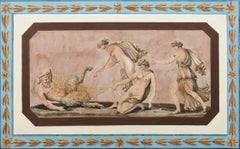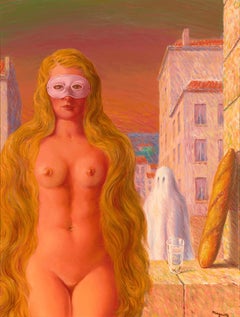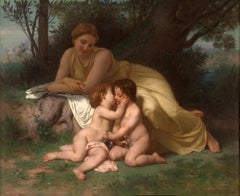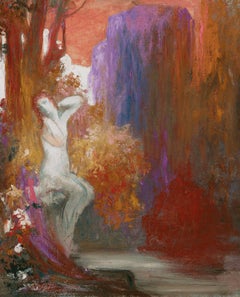Want more images or videos?
Request additional images or videos from the seller
1 of 9
Gil ElvgrenPartial Coverage By Gil ElvgrenCirca 1956
Circa 1956
$149,850List Price
About the Item
- Creator:Gil Elvgren (1914 - 1980, American)
- Creation Year:Circa 1956
- Dimensions:Height: 33.75 in (85.73 cm)Width: 27.88 in (70.82 cm)Depth: 1.5 in (3.81 cm)
- Medium:
- Period:
- Condition:
- Gallery Location:New Orleans, LA
- Reference Number:Seller: 31-72281stDibs: LU18612747402
About the Seller
5.0
Vetted Professional Seller
Every seller passes strict standards for authenticity and reliability
Established in 1912
1stDibs seller since 2013
19 sales on 1stDibs
Typical response time: 4 hours
Authenticity Guarantee
In the unlikely event there’s an issue with an item’s authenticity, contact us within 1 year for a full refund. DetailsMoney-Back Guarantee
If your item is not as described, is damaged in transit, or does not arrive, contact us within 7 days for a full refund. Details24-Hour Cancellation
You have a 24-hour grace period in which to reconsider your purchase, with no questions asked.Vetted Professional Sellers
Our world-class sellers must adhere to strict standards for service and quality, maintaining the integrity of our listings.Price-Match Guarantee
If you find that a seller listed the same item for a lower price elsewhere, we’ll match it.Trusted Global Delivery
Our best-in-class carrier network provides specialized shipping options worldwide, including custom delivery.You May Also Like
"female Nude" oil on canvas by Otto Scholderer (1834-1902)
Located in Gavere, BE
"female Nude" oil on canvas by Otto Scholderer (1834-1902)"
Franz Otto Scholderer (1834 - 1902) was a German painter.
His work is rooted in Romanticism, with influences from Impres...
Category
1890s Jugendstil Nude Paintings
Materials
Canvas, Oil
$17,501 Sale Price
20% Off
H 28.75 in W 22.45 in D 1.58 in
Cupid oil on canvas painting
Located in Sitges, Barcelona
Oil measures 46x55 cm. Frameless.
Category
1990s Realist Figurative Paintings
Materials
Canvas, Oil
"Trust/Truth (Self Portrait)" Contemporary Figurative Nude Painting
Located in East Quogue, NY
Stunning monochromatic realistic contemporary figurative nude portrait painting by Sullivan Giles. Size 40 x 30 inches. Oil on canvas.
The figures Giles depicts are often self-port...
Category
2010s Realist Figurative Paintings
Materials
Canvas, Oil
Sirena 13th
Located in Zofingen, AG
ABOUT THE ARTWORK
"Sirena 13th" is an enchanting portrayal that blends human reflection with the grace of a bird. The palette is lush and vivid, with the bird's plumage displaying a ...
Category
2010s Impressionist Figurative Paintings
Materials
Canvas, Oil
Sirens Art Modern Woman Nude, Bird Woman, canvas, oil - Garden guards 90x75 cm
Located in Zofingen, AG
ABOUT THE ARTWORK
The painting titled "Garden guards" is an evocative fusion of human and avian forms, a surreal ode to the guardians of a mystical orchard. The two central figures, ...
Category
2010s Impressionist Figurative Paintings
Materials
Canvas, Oil
$2,483
H 35.44 in W 29.53 in D 0.79 in
Nude Woman Painting, Modern Art, canvas, oil - PLEASURE - 24x32in (80*60cm)
Located in Zofingen, AG
ABOUT THE ARTWORK
"Nude Woman Painting, Modern Art" captures the timeless grace of the human form through a modern lens. This painting reveals the delicate interplay of light and sha...
Category
2010s Impressionist Figurative Paintings
Materials
Canvas, Oil
$1,419
H 31.5 in W 23.63 in D 0.79 in
RED NUDE - original one of a kind oil painting by Paula Craioveanu FRAMED
By Paula Craioveanu
Located in Forest Hills, NY
"Red Nude", oil on canvas. Original, one-of-a-kind, painting. FRAMED with gold minimalist frame.
Part of "Nude in Interior" solo show, March 2022.
"Red Nude" is a bold and visceral ...
Category
2010s Contemporary Nude Paintings
Materials
Canvas, Oil
$2,700
H 19.69 in W 35.44 in D 0.79 in
Contemporary Figurative Original Painting "I need your friendship so much"
Located in Zofingen, AG
ABOUT THE ARTWORK
The painting "I Need Your Friendship So Much" portrays two figures in a tranquil, introspective state, bound together by a silent understanding. The warm, earthy t...
Category
2010s Expressionist Figurative Paintings
Materials
Canvas, Oil
$3,784
H 45.28 in W 37.41 in D 0.79 in
My main enemy. Contemporary Figurative Oil Painting. Woman Power Symbolism. Red
Located in Zofingen, AG
ABOUT THE ARTWORK
"My Main Enemy" presents a compelling narrative of self-reflection and inner turmoil. The canvas speaks volumes through the bold imagery of a woman holding her hea...
Category
2010s Expressionist Nude Paintings
Materials
Canvas, Oil
$3,784
H 45.28 in W 37.41 in D 0.79 in
Reclining Nude Smoking
By Enrich Torres
Located in Fort Washington, PA
An image of a reclining nude smoking a cigarette against a red and gold background.
Enric Torres-Prat was born in Spain in 1940. He painted many illustra...
Category
Mid-20th Century Figurative Paintings
Materials
Canvas, Oil
More From This Seller
View AllItalian Panel with Satyr and Nymphs
Located in New Orleans, LA
This extraordinary Italian gouache and oil on canvas brings two of the most popular characters from Greek mythology vividly the life - the nymph and the satyr. Both creatures are famed for their carefree natures and lascivious temperaments, and tales abound of satyrs pursing nubile nymphs in order to rape or seduce them, usually with little success. One such narrative humorously unfolds in the present piece, which depicts an indignant satyr captured by three nymphs with a golden net.
The relationship between these two mythological creatures was a popular one for artists throughout the 18th and 19th centuries, though its origins stretch back to antiquity. Both satyrs and nymphs...
Category
Early 19th Century Other Art Style Figurative Paintings
Materials
Canvas, Oil, Gouache
Price Upon Request
Le carnaval du sage by René Magritte
By René Magritte
Located in New Orleans, LA
René Magritte
1898-1967 Belgian
Le carnaval du sage
(The Sage’s Carnival)
Signed “Magritte” (lower right); titled and dated "Le carnaval du sage 1947" (en verso)
Oil on canvas
The enigmatic paintings of René Magritte have become some of the most familiar and celebrated of the Surrealist movement. Among the most influential of the Surrealist painters of the 20th century, Magritte is an artist of international renown, as beloved for his popular appeal as he is for the psychological intensity of his works. The present oil on canvas, entitled Le carnaval du sage, was executed in 1947 at the height of his career, and it is a tour-de-force example of the haunting, mysterious scenes that comprise his oeuvre.
Painted in the years following the Second World War, Le carnaval du sage showcases several recurring themes from Magritte’s oeuvre. Chiefly, a juxtaposition between the visible and the hidden is keenly felt. Throughout his career, Magritte explores the psychological obsession with revealing what is hidden, particularly with regard to the human face. In his Le fils de l’homme, he obscures the face of a man in a bowler hat with an apple, while his Les amants (Metropolitan Museum of Art) conceals the faces of two lovers with white sheets. In Le carnaval du sage, Magritte juxtaposes the blatant nudity of his central figure by masking her face, simultaneously revealing and concealing her from the viewer.
The work also incorporates two of Magritte’s most common tropes – the glass of water and the baguette. Lending the scene a strange sense of domesticity, they appear infinitely familiar and distinctly out of place, and thus heighten the uncanny effect of Magritte’s composition. In the background hovers a ghost obscured by a sheet, a figure which was of particular fascination to Magritte beginning in 1946. He once wrote to his fellow Surrealist Paul Nougé: "I saw in a dream an answer to the problem of the ghost: the traditional ghost draped...
Category
20th Century Post-Impressionist Nude Paintings
Materials
Oil, Canvas
Price Upon Request
Young Mother Contemplating Two Embracing Children by William-Adolphe Bouguereau
By William-Adolphe Bouguereau
Located in New Orleans, LA
William-Adolphe Bouguereau
1825-1905 French
Jeune mère contemplant deux enfants qui s'embrassent
(Young Mother Contemplating Two Embracing Children)
Signed “W-Bouguereau” (bottom ...
Category
19th Century Academic Figurative Paintings
Materials
Canvas, Oil
Ondine
By Pierre Marcel-Béronneau
Located in New Orleans, LA
Mystical and mysterious, a mythological Ondine rests beside an ethereal forest pond in this majestic, original oil on canvas by French Symbolist Pierre-Amédée Marcel-Béronneau. A stu...
Category
20th Century Symbolist Nude Paintings
Materials
Canvas, Oil
Solitude
By Guillaume Seignac
Located in New Orleans, LA
French Academic painter Guillaume Seignac was renowned for his masterful treatment of the idealized nude. His languishing female subjects based on Greco-Roman prototypes were and rem...
Category
19th Century Academic Nude Paintings
Materials
Canvas, Oil
The Bather by Childe Hassam
By Childe Hassam
Located in New Orleans, LA
Childe Hassam
1859-1935 American
The Bather
Signed and dated “Childe Hassam” (lower right)
Oil on canvas
Considered by many to be America’s foremost Impressionist painter, Childe Hassam composed his tranquil and intimate oil on canvas The Bather in the early years of the 20th century. The creation of the artwork aligns with a period of Hassam’s career where the artist’s palette was transforming, matching ever closer with the pale and pastel hues of French Impressionists like Claude Monet. Even the subject — a nude woman — represents a greater alignment with the Impressionist project, as artists of the movement and their non-mythological and non-biblical nudes still generated cries of indecency. With Hassam’s signature brushwork and attention to color, The Bather serves as a dream-like vision, serene and sensuous, of a young woman bathing in a lush forest.
While the artist's skill for landscape painting is on display, it is Hassam's command of form, light and color that brings this canvas to life. He creates a captivating composition, placing the nude subject in the bottom left of the canvas. The soft, undulating curves of the woman's body in contrapposto and the glow of her fair skin are balanced by the strong verticals and deep earth tones of the tall trees to her right. Hassam delicately frames the nude in the vivid blues of the distant water, building luminous color that further draws the viewer’s eye and results in a somewhat voyeuristic appeal — endowing his nude with both a natural innocence and an intentional sensuality.
Born in Dorchester, Massachusetts, Childe Hassam began his artistic career as a freelance illustrator, working for national publications such as Harper’s Weekly, Scribner’s Monthly, and The Century. His first solo exhibition of watercolors took place in Boston in 1883, and he quickly catapulted onto the international scene, winning a bronze medal at the Exposition Universelle in Paris in 1889. The year before the present work was created, he received the Webb Prize from the Society of American Artists for another landscape painted at Gloucester. Hassam would receive numerous other awards throughout his career, most notably the Gold Medal for Distinguished Services to Fine Art from the American Dealers Association. A true master, Hassam depicted a way of life characteristic of both American and French society, and his work elucidates a critical chapter in American art history. Today, his work resides in the Oval Office of the White House and in numerous important museums, including the Metropolitan Museum of Art in New York, the National Gallery of Art in Washington, DC and the Museum of Fine Arts in Boston, among others.
This painting will be included in Stuart P. Feld's and Kathleen M. Burnside's forthcoming catalogue raisonné of the artist's work.
Circa 1905
Canvas: 24 1/2“ high x 20 18” wide
Frame: 35 7/8“ high x 31 1/4” wide x 3 1/4“ deep
Provenance:
Private Collection of William Young...
Category
20th Century Impressionist Nude Paintings
Materials
Canvas, Oil



